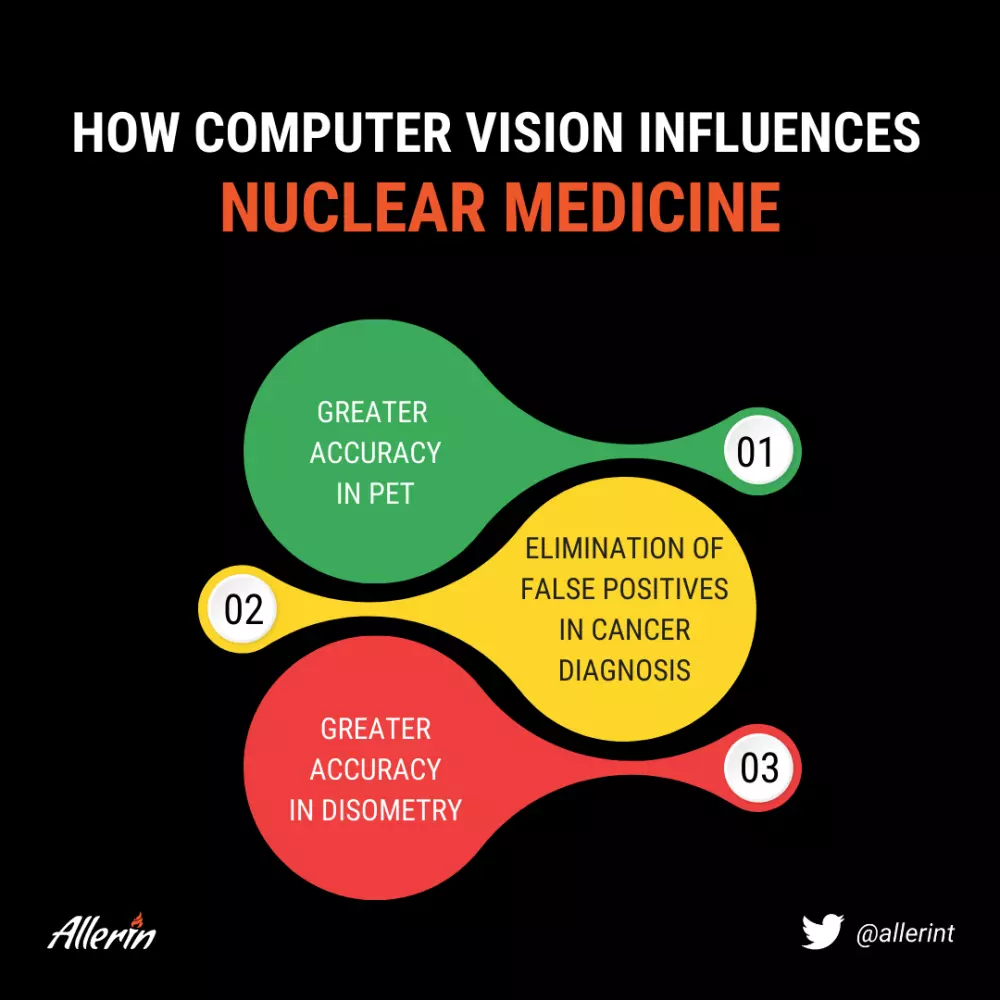Comments
- No comments found

The inclusion of technologies such as AI and computer vision in healthcare can greatly enhance high-precision applications like nuclear medicine.
Nuclear medicine is a subfield of radiology that involves the use of minute amounts of radiation and radiation-based medicines, known as radiopharmaceuticals, to evaluate the composition and functioning of bones and tissue in patients. Today, nuclear medicine and radiology are prominent components of modern healthcare, especially for cancer diagnosis and treatment. X-rays and CT scans are some of the methods that involve radiation usage in healthcare. The use of powerful radiation beams to inhibit the growth of tumors in cancer patients is also a common healthcare application. While health experts involved in the field of nuclear medicine can get the results they need using the equipment and tools available today, intelligent technology can increase the accuracy in diagnosis further. Like with standard medicine, including technologies based on AI and computer vision in healthcare makes such tasks much easier to accomplish effectively for healthcare experts. Additionally, AI and computer vision can be used for speeding up these types of processes.
Computer vision already brings new innovations in healthcare in more ways than one. It can be a similarly disruptive presence in nuclear medicine too. Here are some of the ways in which the inclusion of AI and computer vision in healthcare—and especially nuclear medicine—is justified.
Many of nuclear medicine's main applications involve the diagnoses of illnesses and long-term health conditions based on specific bodily aspects of individuals. One such application is known as Positron Emission Tomography (PET). In this method, health experts use radioactive substances—known as radiotracers—to visualize and monitor the changes that take place in a patient's metabolism, blood flow, hormonal composition, nutrition absorption and other physiological activities. Based on the body part in question, doctors may use different radiotracers for monitoring specific bodily factors using this imaging technique.

One of the principal applications of PET is for doctors to study the biological behavior of tumors and make treatment plans for them. After computer vision-based tools capture the images of irregular cellular formations in the body, doctors can leverage AI-driven applications to scan them to uncover vital information related to potential malignancy and metastasis. Machine learning ascertains a variety of attributes of a tumor from the images captured by computer vision-based image capturing tools. Doctors can also involve radiomics to perform image reconstruction, segmentation, feature extraction and selection and data analysis to get more details about a cluster of cells that have grown in a patient's body. These tasks are carried out using the methods linear regression, clustering, random forest and other methods. In addition to detecting irregular formations and identification of malignant tumors, computer vision and AI also provide macroscopic information about tumor metabolism, reaction to medication and therapy and information regarding the spread of the tumor to different parts of the body. AI generates information that will improve decision-making in the next stage. The involvement of computer vision in healthcare is vital for mapping the path ahead in the radiotherapy workflow. Of late, the forecasting capabilities of machine learning algorithms have developed to the point where health experts can use them to design complex radiotherapy plans for minimal tissue damage from radiotherapy-based cancer treatment.
Generally, using technology and communication tools to detect and, eventually, treat tumors can be challenging for one main reason: the sheer number of false positives in certain types of cancer diagnosis. False positives can be brought closer to zero with the involvement of AI and computer vision in healthcare and radiation-based diagnosis.
One of the most common types of cancer in women is breast cancer. More than 40,000 women are forecasted to have died in 2021 from the disease. Therefore, it is necessary to identify breast cancer at an early stage to increase survival rates. Doctors generally use mammography to diagnose breast cancer. Mammography also involves oncologists using radiations to detect cancerous cell growth in patients. While generally reliable, the overall accuracy of mammography can be suspect at times. To increase the accuracy, doctors use ultrasound tools that help evaluate and classify cell samples for cancer diagnoses more accurately. Ultrasound can detect cancer based on irregularities in fluid-filled cystic lesions in breasts. However, interpreting ultrasounds is also problematic as it throws up several false positives in diagnoses. The rate at which AI and computer vision in healthcare have developed has made automated—and accurate—diagnosis possible. Machine learning uses the generated ultrasound images for this purpose. The datasets that are used to train algorithms of AI and computer vision in healthcare include hundreds or thousands of ultrasound images. Using AI not only improves the accuracy of detecting cancerous cells but also achieves it consistently for different types of systems and platforms that may use different imaging techniques for the purpose.
Just like that, AI and computer vision improve the accuracy of diagnosis in other types of cancer in patients. As a result, the growing involvement of AI and computer vision in healthcare and radiology gradually reduces the number of false-positive diagnoses.
One of the main risks of using radiotherapy for cancer treatment is that the accidental usage of excessive radiation can be life-threatening for patients undergoing them. Using too much radiation is, quite obviously, dangerous, but using less than what is required can make such diagnoses and therapies ineffective. Therefore, calibrating the amount of radiation to be used—also known as dosimetry in nuclear medicine—is essential before doctors can go ahead with major operations. The information collected from AI-based cancer diagnosis is used to resolve dosimetry-related issues by AI-based healthcare systems. Machine learning and AI-based tools determine several factors, such as the bodily region which shows irregular cellular growth and the type and intensity of radiation required to inhibit potential malignancy in such cases. Based on these factors, the algorithms identify the exact areas where the radiation needs to be administered and, more importantly, how much and how intense they need to be from one patient to another. AI-based nuclear medicine tools suggest recommendations to oncologists for carrying out radiotherapy more effectively.

As you will see, two of the main issues that negatively affect AI and computer vision-based tasks in non-nuclear healthcare are prevalent in nuclear medicine too.
The working of complex machine learning algorithms keeps getting more and more ambiguous with time. So, while AI and computer vision-based applications will provide the end results in diagnosis and treatment with zero error, some radiologists and health experts may still have reservations regarding the basis on which specific decisions or recommendations are made by algorithms. The black box problem of AI gets magnified in healthcare as patients’ lives are on the line in the most literal sense.
The dosimetry-related decision-making process can be used as an example to demonstrate the black box problem. The algorithms process a whole host of factors before zeroing in on the exact location, amount and intensity of radiation to be used. The logic behind such complex decision-making is almost always hidden in the dark with AI applications.
When nuclear medicine diagnosis and treatments are completely automated with AI and robotics, there are chances that discriminatory decisions and actions will come through AI-based systems. Already, there have been instances of racism and discrimination surreptitiously creeping into the working of nuclear medicine and radiology-based healthcare applications. An example of this bias is the preferential classification of white people during medical imaging and diagnosis. Developers of AI and computer vision-based applications can address AI bias by widening the scope of datasets used for model training. Including people from diverse cultural and racial backgrounds during model development can reduce and, eventually, eliminate bias from healthcare operations.
The use of radiation and quantum science has always offered new ideas and solutions for experts in several fields. Data-driven technologies such as AI and computer vision add more certainty and seamlessness to such solutions. The applications listed here may seemingly paint a picture that AI and computer vision only augment nuclear medicine for certain types of diseases—which is not true. Using AI and computer vision in healthcare and radiology is useful for disrupting several other operations apart from the cancer-related ones, which are the most apparent.
Naveen is the Founder and CEO of Allerin, a software solutions provider that delivers innovative and agile solutions that enable to automate, inspire and impress. He is a seasoned professional with more than 20 years of experience, with extensive experience in customizing open source products for cost optimizations of large scale IT deployment. He is currently working on Internet of Things solutions with Big Data Analytics. Naveen completed his programming qualifications in various Indian institutes.
Leave your comments
Post comment as a guest